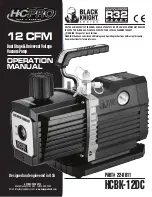
Page 3
HPXA16 SERIES
Parts Arrangement
Figure 1
CONTACTOR
VAPOR VALVE AND GAUGE
PORT
TWO−STAGE COMPRESSOR
FILTER DRIER
RUN CAPACITOR
START CAPACITOR
(−024 UNIT ONLY)
DEFROST CONTROL
CHARGE COMPENSATOR
(−048 UNITS)
TXV/CHECK VALVE
DISCHARGE LINE
COMPRESSOR TERMINAL PLUG
VAPOR LINE
LOW PRESSURE SWITCH
DISCHARGE TEMPERATURE
SENSOR
HIGH PRESSURE SWITCH
Setting the Unit
CAUTION
In order to avoid injury, take proper precaution when
lifting heavy objects.
These units operate under a wide range of weather condi-
tions; therefore, several factors must be considered when
positioning the outdoor unit. The unit must be positioned to
give adequate clearances for sufficient airflow and servic-
ing. Refer to figure 2 for installation clearances.
1. Place a sound−absorbing material, such as Isomode,
under the unit if it will be installed in a location or posi-
tion that will transmit sound or vibration to the living
area or adjacent buildings.
2. Mount unit high enough above ground or roof to allow
adequate drainage of defrost water and prevent ice
build−up.
3. In heavy snow areas, do not locate unit where drifting
will occur. The unit base should be elevated above the
depth of average snows.
NOTE − Elevation of the unit may be accomplished by
constructing a frame using suitable materials. If a sup-
port frame is constructed, it must not block drain holes
in unit base.
30"
(762 mm)
as noted
Installation Clearances
NOTE − A service access clearance of 30" (762 mm) must be main-
tained in front of the service access panel. Clearance to one side must
be 36" (914 mm). Clearance to one of the remaining two sides may be
12" (305 mm) and the final side may be 6" (152 mm).
NOTE − A clearance of 24" (610 mm) must be maintained between
two units.
NOTE − 48" (1219 mm) clearance required on top
of unit. Maximum soffit overhang is 36" (914 mm).
Figure 2
as noted
as noted
4. When installed in areas where low ambient tempera-
tures exist, locate unit so winter prevailing winds do
not blow directly into outdoor coil.
5. Locate unit away from overhanging roof lines which
would allow water or ice to drop on, or in front of, coil
or into unit.




































